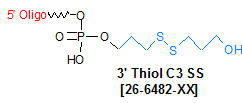
Modification : Thiol SS-C3 3'
Catalog Reference Number
Category
Modification Code
5 Prime
3 Prime
Internal
Molecular Weight (mw)
Extinction Coeficient (ec)
Technical Info (pdf)
Absorbance MAX
Emission MAX
Absorbance EC
26-6482
Conjugation Chemistry
[SS-C3-3]
N
Y
N
154.12
-
PS26-6482.pdf
-
-
-
| Catalog No | Scale | Price |
| 26-6482-05 | 50 nmol | $106.00 |
| 26-6482-02 | 200 nmol | $106.00 |
| 26-6482-01 | 1 umol | $138.00 |
| 26-6482-03 | 2 umol | $206.00 |
| 26-6482-06 | 5 umol | $621.00 |
| 26-6482-10 | 10 umol | $1,101.00 |
| 26-6482-15 | 15 umol | $1,376.00 |
| Discounts are available for Thiol SS-C3 3'! |
| Modification* Discount Price Structure |
|
1 site/order
|
List price
|
|
2 sites/order
|
10% discount
|
|
3 sites/order
|
20% discount
|
|
4 sites/order
|
30% discount
|
|
5-9 sites/order
|
50% discount
|
|
10+ sites/order
|
60% discount
|
|
*Exceptions apply
|
Note: Prior to use, reduce any disulfide formation using 100 mM TCEP or DTT for 30 minutes at room temperature.TCEP 0.5M solutions is available from Gene Link, Catalog Number: 40-5116-10. TCEP use is recommended for reduction as conjugation efficiency are 2-3% higher if TCEP is used.
TCEP 0.5M solution
Thiol Reduction Protocol
Thiol-SS-C3 is a disulfide-containing modifier designed to functionalize an oligonucleotide with a reactive thiol (sulfhydryl) group at the 5' or 3'-end. This modification is incorporated into the oligonucleotide as a disulfide during oligonucleotide synthesis, in order to protect the thiol group from undesired side reactions. The oligo is supplied as a disulfide and the customer has to reduce it with TCEP or DTT or other reducing agent to generate the reduced thiol group. The thiol group is separated from the oligo by a three-carbon spacer arm, to reduce steric interactions with the end of the oligo.
Thiolated oligonucleotides can be labeled with thiol-reactive dye / happen iodoacetamides or maleimides (for example, lucifer yellow iodoacetamide or fluorescein maleimide) for use as hybridization or PCR-based detection probes (1). They also can be conjugated to enzymes (for example, alkaline phosphatase or horseradish peroxidase), through bifunctional linkers (2). Finally, thiolated oligos can be attached to glass slides or gold surfaces for use in various microarray or nanoelectronic applications (3,4). However, because oligos labeled with only one thiol slowly dissociate from a gold surface at the temperatures (60C to 90C) and high salt concentrations commonly used to denature DNA duplexes (5), Gene Link recommends that researchers who plan to use such conditions to repeatedly strip and re-probe oligo arrays based on thiol-gold surface conjugation modify the oligos with DTPA, which incorporates two thiol groups into the oligo, thereby allowing for a more stable attachment to gold. For further information on DTPA, please see its technical sheet.

References
1. Connolly, B.A., Rider, P. Chemical synthesis of oligonucleotides containing a free sulphydryl group and subsequent attachment of thiol specfic probes. Nucleic Acids Res. (1985), 13: 4485-4502.
2. Ghosh, S.S, Kao, P.M., McCue, A.W., Chappelle, H.L. Use of maleimide-thiol coupling chemistry for efficient syntheses of oligonuclotide-enzyme conjugate hybridization probes. Bioconjugate Chem. (1990), 1: 71-76.
3. Roger, Y-H., Jiang-Baucom, P., Huang, Z-J., Bogdanov, V., Anderson, S., Boyce-Jacino, M.T. Immobilization of oligonucleotides onto a glass support via disulfide bonds: A method for preparation of DNA microarrays. Anal. Biohem. (1999), 266: 23-30.
4. Ackerson, C.J., Sykes, M.T., Kornberg, R.D. Defined DNA/nanoparticle conjugates. Proc. Natl. Acad. Sci. USA (2005), 102: 13383-13385.
5. Li, Z., Jin, R., Mirkin, C.A., Letsinger, R.L. Multiple thiol-anchor capped DNA-gold nanoparticle conjugates Nucleic Acids Res. (2002), 30: 1558-1562.
- Thiol SS-C3 3'
